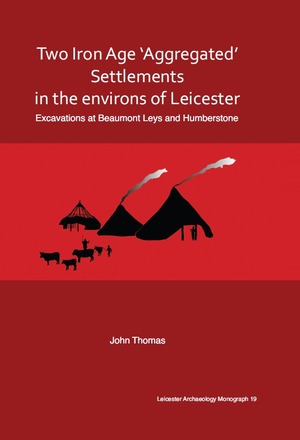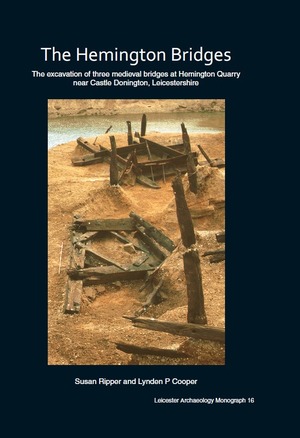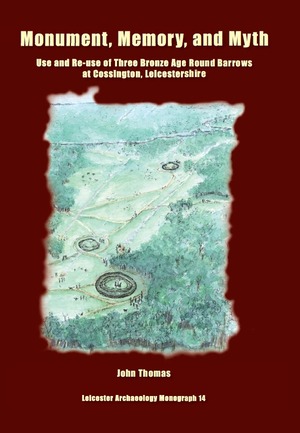University of Leicester Archaeological Services
Leicester archaeology monographs
ULAS publishes select projects as part of the School of Archaeology and Ancient History's Leicester Archaeology Monographs.
 The Anglo-Saxon Settlement at Eye Kettleby, Leicestershire
The Anglo-Saxon Settlement at Eye Kettleby, Leicestershire
- Gavin Speed and Neil Finn
- Leicester Archaeology Monograph 27 (2024)
The early Anglo-Saxon settlement discovered at Eye Kettleby, is the largest excavated in the region, and one of only a few sites of similar size of this type in England. This volume presents the results of the 1990s excavations at the site by University of Leicester Archaeological Services. These have helped transform understandings of this period, both in the region and more widely, allowing improved recognition of the structural evidence, and better understanding of the material culture.
Unusually, as many as around 50 structures of post-built and sunken type were preserved at Eye Kettleby, along with other settlement features. The settlement dates to the 5th to 7th centuries AD, and is dated by supporting radiocarbon and a material culture assemblage that included a notable group of bone combs and a large pottery assemblage offering new insights on regional ceramic traditions. Along with the important botanical and zooarchaeological data, the finds have enriched our interpretation of the lives of the people living there.
The results are brought together to analyse the development and character of the settlement, and the nature of the activities undertaken there. The book concludes by reviewing Eye Kettleby’s place in the early Anglo-Saxon landscape of Leicestershire and Rutland and assesses its significance in the broader context of Anglo-Saxon England, with some implications for future settlement studies of this period.
“…the publication of this site is extremely important for our understanding of the period…”
Peter Liddle (Former Senior Archaeologist, Leicestershire County Council)
“…the excavation report on Eye Kettleby -- a site of national significance -- has been produced to a consistently high standard and certainly merits publication”
Helena Hamerow (Professor of Early Medieval Archaeology, University of Oxford)
- The book will be available soon from Shop@le.
 Life in Roman and Medieval Leicester: Excavations in the town’s north-east quarter, 1958-2006
Life in Roman and Medieval Leicester: Excavations in the town’s north-east quarter, 1958-2006
- Richard Buckley, Nicholas J. Cooper and Mathew Morris
- Leicester Archaeology Monograph 26 (2021)
This volume describes what lay below the Highcross Leicester Shopping Centre, the largest area to become available for investigation in the core of the historic town, a model development-led project undertaken by University of Leicester Archaeological Services from 2003–6 and funded by Hammerson. These and earlier excavations in the north-east quarter have illuminated the evolving story of the town, presented here in the most comprehensive book ever written on the archaeology of Leicester.
“This synthetic approach is an excellent way to bring together the evidence of multiple interventions and provide an accessible, up-to-date account of the Roman town… an important publication, not just for Roman Leicester, but for Roman Britain more widely”
Britannia, 54, 2023, pp. 464 – 465
“…the quality of the analysis is unfailingly high. This is urban archaeology done to a high standard by an experienced, thoughtful team from the University of Leicester Archaeological Services… One senses this is a book the numerous authors were itching to write: a chance to set down the results of decades of thought and acquired knowledge on the archaeology of their home city. The text is amplified by an attractive design and is lavishly illustrated”
Archaeological Journal, 180(2), 2023, pp. 177-179.
- More on this can be explored in our blog
- The book is available from Shop@Le
 Hoards, Hounds and Helmets – A conquest period ritual site at Hallaton, Leicestershire
Hoards, Hounds and Helmets – A conquest period ritual site at Hallaton, Leicestershire
-
- Vicki Score
Leicester Archaeology Monograph 21 (2011)
The Hallaton hoards are among the most spectacular and important archaeological discoveries ever made in the East Midlands. They have completely rewritten our understanding of relations between Iron Age Britain and the Roman world in the period just before and after the Conquest in the first century AD and provide a new model for understanding other deposits of metalwork and coins from across late Iron Age Europe.
“…with model texts, a clear series of illustrations…(this) will remain an indispensable study of a fascinating transitional period in the history of England”
Journal of Roman Archaeology, 29, 2016, pp. 812 - 815.
“This well-illustrated and comprehensive report will deservedly place Hallaton as fundamental to discussions of the Late Iron Age–Roman transition.”
Britannia, 44, 2013, pp. 425 - 426
- The book is available from Shop@Le
 Bronze Age Ceremonial Enclosures and Cremation Cemetery at Eye Kettleby, Leicestershire
Bronze Age Ceremonial Enclosures and Cremation Cemetery at Eye Kettleby, Leicestershire
- Neil Finn
- Leicester Archaeology Monograph 20 (2011)
Excavations at Eye Kettleby, near Melton Mowbray have revealed prehistoric activity spanning four millennia, from the Mesolithic to the late Bronze Age. A monumental landscape of ring ditches and enclosures emerged in the Early Bronze Age, later the site of a cremation cemetery, in use periodically over several centuries. In the late Bronze Age, two pit alignments marked a restructuring of the landscape with the establishment of a small settlement. An extensive radiocarbon dating programme has provided an unparalleled insight into the development of Bronze Age funerary practices in the region.
“this adds important detail to a period known mostly from round barrows and ring ditches… This report certainly makes a contribution to understanding how complex the archaeology of the second millennium BC can be, the significance of regional diversity and how we interpret the wider picture across the Midlands and the fenland edge” Proceedings of the Prehistoric Society, 2012.
“This is a well-produced and fully documented report; yet another excellent publication from the University of Leicester Archaeological Services, in traditional genre but with an innovative structure. It will make an important contribution to the prehistory, especially the Bronze Age, of the East Midlands…”
Archaeological Journal, 169(1), 2012, p. 555
- The book is available from Shop@Le
 Two Iron Age ‘Aggregated’ Settlements in the environs of Leicester
Two Iron Age ‘Aggregated’ Settlements in the environs of Leicester
- John Thomas
- Leicester Archaeology Monograph 19 (2011)
Excavations at Beaumont Leys and Humberstone, on the outskirts of Leicester, revealed two Iron Age ‘aggregated’ settlements, closely associated with long-lived linear boundaries. Both sites were predominantly involved with livestock farming and are significantly larger than other previously excavated settlements, with Humberstone being the largest Iron Age site yet found in Leicestershire. The scale and longevity of the two sites, spanning much of the Iron Age, is reflected in the material culture, which includes the largest pottery and animal bone assemblages from contemporary sites in the East Midlands.
“…it should be recommended reading for all those in interested in the British Iron Age”
Proceedings of the Prehistoric Society, 2013.
- Out of print – available soon as digital download.
 The Hemington Bridges: The excavation of three medieval bridges at Hemington Quarry, near Castle Donnington, Leicestershire
The Hemington Bridges: The excavation of three medieval bridges at Hemington Quarry, near Castle Donnington, Leicestershire
- Susan Ripper and Lynden P. Cooper
- Leicester Archaeology Monograph 16 (2009)
Rescue excavations at Hemington Quarry, Leicestershire, between 1993-1998 allowed the recording of three successive medieval bridges preserved beneath gravel bar deposits and alluvium. This crossing over the River Trent was part of a major arterial route, the King’s Highway, linking London and the south to Derby and the north. This monograph presents the results of a multi-disciplinary study that examined the bridges’ structural technology, stone and woodworking practices, geomorphological context, chronology and historical context. Particular emphasis is placed upon the earliest structure, built c. AD 1097, this being a unique survival of Saxo-Norman timber engineering and vernacular architecture.
“…a substantial and well-illustrated volume written by experts in a range of fields”
The English Historical Review, CXXVI, 522, 2011, pp.1188–1190
- The book is available from Shop@Le
 Monument, Memory and Myth: Use and re-use of three Bronze Age Round Barrows at Cossington, Leicestershire
Monument, Memory and Myth: Use and re-use of three Bronze Age Round Barrows at Cossington, Leicestershire
- John Thomas
- Leicester Archaeology Monograph 14 (2008)
This monograph describes the remains of three closely related Bronze Age round barrows excavated during gravel quarrying at Cossington, Leicestershire. Together the three barrows offer an important addition to our understanding of the enduring significance of such monuments, not only for the original users, but for following generations.
“This well-illustrated and important study raises significant issues”
Archaeological Journal, 2010, p.539.
“…this book makes a useful…contribution to the study of Early Bronze Age funerary monuments and their after-lives in Britain…of considerable interest in terms of our knowledge of the Bronze Age in the English Midlands...”
Proceedings of the Prehistoric Society, 2010
- The book is available from Shop@Le